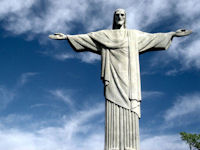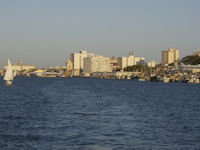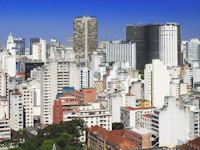Brazil World Cup 2014: Host cities
In the country renowned for its passion for football, we explore what the 12 host cities can offer to fans planning to head to one of South America’s most thrilling destinations for the Brazil World Cup 2014 after England's nail-biting qualifying match victory against Poland.
Brazil World Cup 2014: Belo Horizonte
Parks, trees and lush squares give this metropolitan city a peaceful feeling. The centre of Belo Horizonte is Sete de Setembro Square, where an obelisk stands commemorating Brazilian independence. Station Square is another popular attraction, especially for year-round festivals and performances. One of the city’s best festivals is Comida di Buteco offering a chance for visitors to experience top cuisine. Be sure to visit Café Nice, a traditional eatery favoured by many Brazilian celebrities and politicians.
Brazil World Cup 2014: Brasília
With large amounts of open space and a number of unique architectural gems, Brazil’s capital city shouldn’t be missed. The Metropolitan Cathedral, Palacio do Congresso (Capitol Building) and the Presidential Palace are among the treasures which dot this innovatively planned city; viewed from the sky, it looks like a plane. Climb Television Tower at the intersection of Brasília’s two main avenues for a bird’s eye view of this UNESCO World Heritage site.
Brazil World Cup 2014: Rio de Janeiro
The skyscrapers of this formidable city rise between world-famous beaches and steep granite peaks. Make your way up to the infamous Cristo Redentor statue (Christ the Redeemer), which overlooks Rio with outstretched arms and offers staggering views of the city.
 Rio de Janeiro's Christ the Reedemer statue
Rio de Janeiro's Christ the Reedemer statue123rf.com
Visit Tijuca National Park, the world’s largest urban forest, where waterfalls, grottoes and walking trails can be discovered. Take a break from the city and head to legendary Copacabana, the beach where beautiful Cariocas bask.
Brazil World Cup 2014: Cuiabá
Cuiabá’s central location is unbeatable. It is the gateway to the Pantanal, Brazil’s vast tropical wetlands, which offers immense wildlife-viewing opportunities. Canoe along one of its many rivers and you’re likely to see monkeys, giant river otters and capybara. Elsewhere, the highlands area of Chapada dos Guimaraes offers swimming and hiking opportunities, plus mysterious canyons and crags. If it’s waterfalls you’re after, Águas Quentes is an aquatic park with natural hot springs.
Brazil World Cup 2014: Curitiba
Another example of enlightened urban planning, Curitiba has it all, whether it’s nature or the hustle and bustle of a city you desire. Visit the pedestrianised historic centre or one of the city’s 30 municipal parks and woodlands scattered with walking and biking trails. Catch a show at the Wire Opera House, where the building’s transparent ceiling creates a spectacle out of the night sky. Avid shoppers should head for Rua 24 Horas where more than 30 shops are open for business around the clock.
Brazil World Cup 2014: Fortaleza
With 25km (15 miles) of beaches and pulsating nightlife, it’s no wonder Fortaleza in northeast Brazil is rapidly gaining popularity. Visit Praia do Futuro or Future Beach and eat at one of its barracas, kiosk-style restaurants and bars built into the sand which serve delicious fresh seafood. By night, Fortaleza’s beaches are transformed into party zones with live music and dancing. Alternatively, head to Beira Mar Avenue and experience the forró, a traditional Brazilian dance form that originated in the region.
Brazil World Cup 2014: Manaus
Wildlife and nature lovers can experience the thrill of the Amazon from the steaming hot gateway city of Manaus. Venture out by boat to the Meeting of the Waters, where the tar-black hues of the Rio Negro and the sandy-coloured Rio Solimões run side by side for 10km (6 miles) before joining to create one of the world’s mightiest rivers. A riverboat tour or rainforest stay offers the unforgettable chance to capture a glimpse of some of the Amazon’s incredible bird and animal life such as pink dolphins, spider monkeys and jaguars.
Brazil World Cup 2014: Natal
The city of Natal may be short of must-see attractions but the consolation is its plethora of beaches. With endless stretches of sun-baked sand, this is one of Brazil’s top destinations for beach lovers who want nothing better than to frolick in the surf all day. One of the best ways to sample Natal’s beaches and giant sand dunes is on an adrenaline-charged, dune-buggying excursion – a must for thrill seekers. Alternatively, head to Lagoa de Jucuma. Aerobunda is the latest craze there; it involves whizzing down a long and high aerial wire into the sea.
Brazil World Cup 2014: Porto Alegre
Situated along Lagoa dos Patos or Ducks Lagoon, Porto Alegre is the point at which five rivers converge.
 Visit Duck's Lagoon, one of the largest in South America
Visit Duck's Lagoon, one of the largest in South AmericaCreative Commons / Eutrophication&Hypoxia
Casa da Cultura Mario Quintana is the cultural hub of the city and includes a library, art gallery, theatre, cinema, café and bookshop. Cathedral Metropolitana is another landmark in Porto Alegre, and it acts as the divider between the city’s Downtown and its prosperous neighbourhoods.
Brazil World Cup 2014: Recife
Recife has been dubbed the ‘Brazilian Venice’ thanks to the canals and waterways that crisscross the city. Its fine beaches and colonial architecture also never fail to impress. The Instituto Ricardo Brennand is a mock medieval castle located on expansive grounds where a massive collection of art, swords, armour and historical artifacts are held. If time permits, a visit to Recife’s neighbouring town of Olinda is well worth the effort. Olinda maintains an artsy vibe with a number of galleries and vibrant street music.
Brazil World Cup 2014: Salvador
African influence runs deep in Salvador, infusing this laid-back, Brazilian city with a unique cultural vibe. The city is distinctly divided into the Cidade Baixa (Low City) and Cidade Alta (High City) linked by the art deco Lacerda Elevator. The old colonial centre, known as the Pelourinho Quarter, cannot be missed. Here, pretty churches, convents and pastel-coloured facades line hilly, cobbled streets. There are a number of museums to explore and a culinary school where local dances are performed in the evenings. If you’re looking to take a piece of this city home with you, visit Mercado Modelo for local crafts and Afro-Brazilian cult objects.
Brazil World Cup 2014: Sao Paulo
Sao Paulo, Brazil’s economic powerhouse, is a buzzing, bewildering metropolis where extremes of poverty and wealth live side by side.
 Sao Paulo cityscape
Sao Paulo cityscape 123rf.com
Despite its contradictions, there is much to entice visitors in this crowded, congested urban jungle such as sophisticated shops, restaurants, bars and clubs that wouldn’t look out of place in London or New York. Indulge like a Paulistano by dining at a churrascaria where a non-stop feast of barbecued meat is served.
Do you have any Feedback about this page?
© 2025 Columbus Travel Media Ltd. All rights reserved. No part of this site may be reproduced without our written permission, click here for information on Columbus Content Solutions.









 You know where
You know where